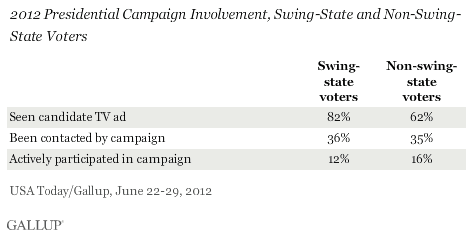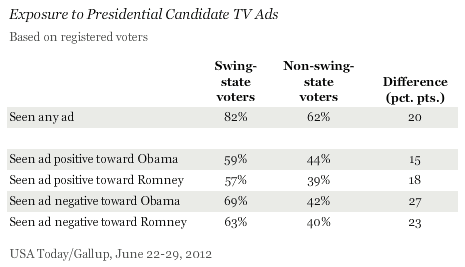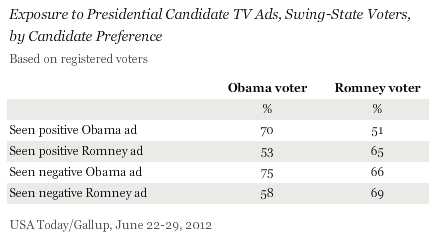PRINCETON, NJ -- Voters in 12 key presidential election swing states have already been exposed to a large dose of campaign advertising, with 82% reporting having seen a campaign ad on television, compared with 62% of non-swing-state voters. At the same time, swing-state voters are no more likely than non-swing-state voters to say they have been contacted by one of the campaigns or to have been an active participant in the campaign.

The results are based on the most recent USA Today/Gallup Swing States poll, conducted June 22-29. The swing-state survey interviews voters in Colorado, Florida, Iowa, Michigan, Nevada, New Hampshire, New Mexico, North Carolina, Ohio, Pennsylvania, Virginia, and Wisconsin -- the 12 states whose results are most likely to decide the election, and where much of the campaign activity is likely to be focused.
The lack of difference in campaign contact could change closer to the election, as the campaigns focus their efforts on getting out the vote in the swing states, particularly in the final days of the campaign. Now the campaigns may be focusing more on fundraising, and their efforts in that regard would not need to focus on a limited number of states crucial to deciding the electoral vote outcome.
Within the swing states, Obama and Romney voters report roughly equal levels of campaign contact (37% and 36%, respectively) and campaign activity (13% and 11%).
Swing-State Voters Seeing a Lot of Negative Ads
Political campaigns rely heavily on television ads because it is a more effective way to convey their messages to a larger number of voters than holding campaign rallies or going door to door. Thus, given the swing states' importance, it makes sense that swing-state voters are more likely to have seen ads, particularly negative ads, than those in non-swing states.
As of late June, 69% of swing-state voters had reported seeing a television ad that was negative toward Barack Obama, and 63% had reported seeing an ad negative toward Mitt Romney. Fewer, but still a majority of swing-state voters, reported seeing positive ads toward Obama (59%) or Romney (57%).
In contrast, non-swing-state voters were about as likely to report having seen negative as positive Obama or Romney ads, with the percentages seeing each type of ad ranging from 39% to 44%.

Thus, swing-state voters are far more likely than non-swing-state voters to have been exposed to a negative ad toward Obama (69% to 42%) or Romney (63% to 40%). Swing-state voters are also more likely to have seen positive ads toward either candidate, but the differences are smaller.
Voters Say Ads Generally Reinforce Thinking
For the most part, swing-state voters say the ads they have seen generally reinforce what they were already thinking about the candidates (70%), rather than changing their views (8%). The figures are similar, 66% and 8%, respectively, among non-swing-state voters.
One reason candidate ads may largely serve a reinforcing function is that voters may pay more attention to ads that focus on their chosen candidate. The data provide some support for this notion. Among those residing in the swing states, Obama voters are more likely than Romney voters to say they have seen positive and negative Obama ads. The same is true with respect to Romney voters, who are more likely than Obama voters to report seeing positive and negative Romney ads.

Obama voters are somewhat more likely to say they have seen a positive (70%) or negative (75%) ad about their chosen candidate than Romney voters are to report seeing a positive (65%) or negative (69%) ad about theirs.
Implications
The swing states will surely be the focus of much of the Obama and Romney campaigns' efforts this year. That is already evident from the standpoint that swing-state voters are much more likely to say they have seen a presidential campaign ad than those in non-swing states.
So far, that increased campaign exposure has not made swing-state voters any more likely to participate in the campaign. And to date, the campaigns have not contacted a proportionately greater number of swing-state voters than non-swing-state voters, at least according to the voters' self-reports. This suggests that the campaigns are not necessarily ignoring those in less competitive states, and that voters in those states are not necessarily more detached from the campaign.
However, whether differences in campaign contact and participation emerge between swing-state and non-swing-state voters as Election Day approaches will tell whether the intense focus on those states spurs voters to get involved or turns them off to the presidential campaign.
Survey Methods
Results for voters in 2012 Election swing states are based on telephone interviews conducted June 22-29, 2012, on the Gallup Daily tracking survey, with a random sample of 1,200 registered voters, aged 18 and older, living in Colorado, Florida, Iowa, Michigan, Nevada, New Hampshire, New Mexico, North Carolina, Ohio, Pennsylvania, Virginia, and Wisconsin. The data represent a subset of Gallup's national daily tracking survey for those dates. The swing-state data are weighted to be demographically representative of the combined population in those 12 states.
For results based on the total sample of swing-state registered voters, one can say with 95% confidence that the maximum margin of sampling error is ±4 percentage points.
For results based on the total sample of 577 registered voters in non-swing-state voters, one can say with 95% confidence that the maximum margin of sampling error is ±5 percentage points. Interviews with non-swing-state voters were conducted as part of Gallup Daily tracking June 25-26.
Interviews are conducted with respondents on landline telephones and cellular phones, with interviews conducted in Spanish for respondents who are primarily Spanish-speaking. Each sample includes a minimum quota of 400 cell phone respondents and 600 landline respondents per 1,000 national adults, with additional minimum quotas among landline respondents by region. Landline telephone numbers are chosen at random among listed telephone numbers. Cell phone numbers are selected using random-digit-dial methods. Landline respondents are chosen at random within each household on the basis of which member had the most recent birthday.
Samples are weighted by gender, age, race, Hispanic ethnicity, education, region, adults in the household, and phone status (cell phone only/landline only/both, cell phone mostly, and having an unlisted landline number). Demographic weighting targets are based on the March 2011 Current Population Survey figures for the aged 18 and older non-institutionalized population living in U.S. telephone households. All reported margins of sampling error include the computed design effects for weighting and sample design.
In addition to sampling error, question wording and practical difficulties in conducting surveys can introduce error or bias into the findings of public opinion polls.
View methodology, full question results, and trend data.
For more details on Gallup's polling methodology, visit www.gallup.com.
